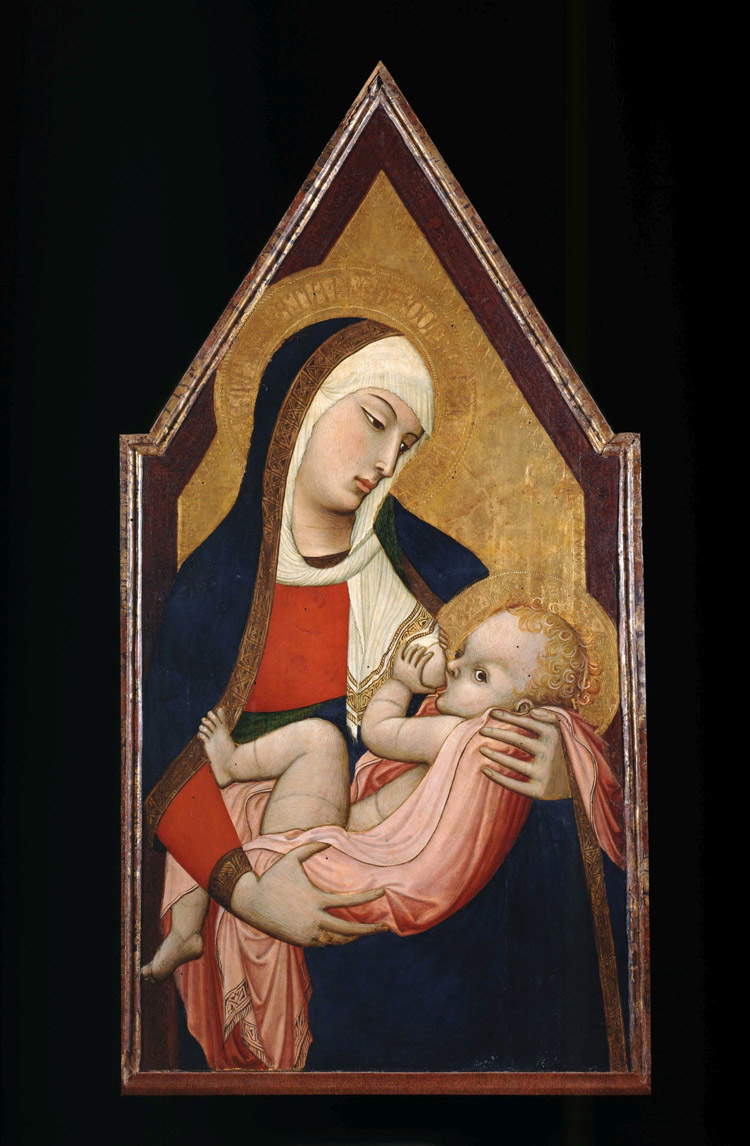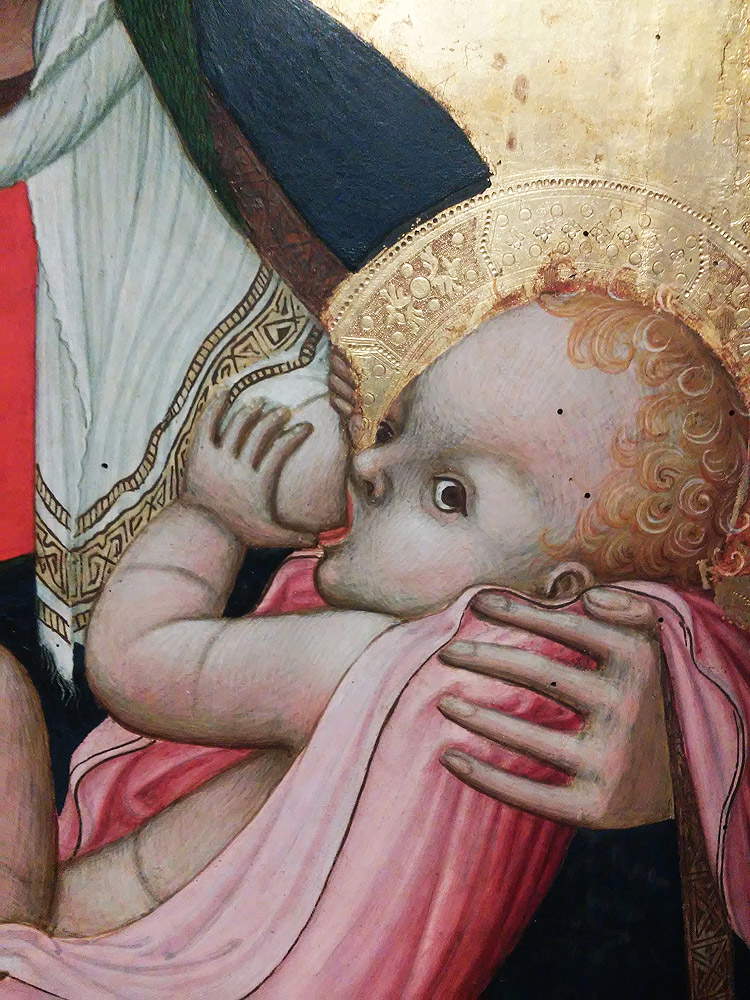"The most beautiful panel by Ambrogio Lorenzetti in existence": the Madonna of Milk in Siena
It was a midwinter day in 1879 when Charles Fairfax Murray entered the church of San Francesco in Siena with the specific intention of going to see a work by Ambrogio Lorenzetti that was kept there, in the chapel of the Archbishop’s Seminary. Murray was only 30 years old but had already been in Italy for eight years: a Pre-Raphaelite painter with solid knowledge of Italian art, he had come from London to make copies of Italian works to send to John Ruskin. And then he had stopped: after marrying an Italian girl and settling in Florence, he had begun collaborating with Giovanni Battista Cavalcaselle. And it was precisely in 1879 that he was traveling through Tuscany, with the aim of compiling a catalog of Pietro and Ambrogio Lorenzetti’s works for Cavalcaselle.
We can only imagine Murray’s astonishment when he saw before him the Madonna del Latte, given the enthusiastic tones in which he described the work in a letter he sent to his colleague on January 20, after he had made a canvas copy of the painting: for the young Englishman, the Madonna del Latte was “the most beautiful panel by Ambrogio in existence,” and Murray’s opinion evidently convinced Cavalcaselle to include the work in his History of Painting in Italy, a fact that would later make it well known to art-historical studies, and which was the prerequisite for it to become one of the most recognizable and iconic images of Ambrogio Lorenzetti’s art.
In the monumental historiographical undertaking that the Venetian art historian drafted together with Joseph Archer Crowe, the Madonna of Milk is described as “a graceful panel painting,” which “represents in life-size the half-figure of the Madonna with the Putto at her breast in the act of sucking, who with one hand on her breast turns playfully to the beholder.” And perhaps the adjective “playful” is one of the keys to understanding this wonderful painting, despite the Madonna’s apparent seriousness. She still retains a rather Duccioesque profile, although the features of this Virgin are more noble than those of Duccio’s Madonnas: the almond-shaped eyes, the slightly elongated profile, the fine arched eyebrows, the tender, diaphanous complexions. She wears, in keeping with tradition, an ultramarine blue maphorion , with a gold border decorated with geometric motifs, covering a white veil wrapped in very thin folds, outlined with certain virtuosity, and ending with a golden hem that seems almost to continue the girdle, tightly drawn over the scarlet tunic at breast height. Her figure is traced according to an unusual spatial setting, the young Catalan scholar Ireneu Visa Guerrero has pointed out: “both Mary and Jesus are shifted with respect to the central axis, a position that allows Ambrogio to pretend that they pass beyond the space circumscribed by the frame, which, in turn, surely alludes to a throne.”
 |
| Ambrogio Lorenzetti, Madonna of Milk (c. 1325; tempera and gold on panel, 96 x 49.1 cm; Siena, Museo Diocesano) |
 |
| Ambrogio Lorenzetti, Madonna of Milk, detail |
And on that throne, to which the very cusped form of the panel refers, the Child evidently does not feel at ease, for he is not as calm as his mother. On the contrary: he fidgets, he kicks, he eagerly grasps the Virgin’s breast with his hands to suggest milk, but he turns his gaze away almost suspiciously. And the mother must hold it firmly, lest it slip from the pink cover it is shedding, with the action of the legs that find no pose and are caught by the painter in a bizarre, unusual, new position: they are bent, almost crossed one over the other, with the left heel resting on the right knee and the sole of the foot pushing on the mother’s arm instead. Observe the realistic detail of the index and middle fingers of the Madonna’s right hand, which are spread apart to make a greater grip on the Child’s terga: it is from a detail like this that the unusual naturalness of Ambrogio Lorenzetti’s painting is revealed. And it was precisely by observing the Child’s attitude, a fact entirely original to Sienese painting, that Cavalcaselle attributed to him the “scherzoso” (playful) one.
The artist painted the panel around 1325: comparisons with other works of the time suggest this to us, first and foremost the cycle of frescoes that Ambrogio painted with his brother Piero precisely in San Francesco in the early 1320s (and which were, moreover, rediscovered under a layer of dullness some 20 years before Murray visited the church), where the characters present connotations quite similar to those of the Madonna del Latte. We do not know with certainty where it was originally located: the work is first attested in 1439, at the Augustinian hermitage of Lecceto, near Siena, and there it remained until 1866, when it was moved to the Seminary chapel in San Francesco, along with its seventeenth-century frame, which was later removed. Moved again in 1966 to the Archbishop’s Palace in Siena, it has now become part of the collection of the Tuscan city’s Diocesan Museum.
In executing his Virgo lactans, his Madonna caught in the intimate and tender act of suckling the Child, Ambrose had revived the Byzantine tradition of the Virgin Galaktotrophousa, which was already widely practiced in the Sienese sphere anyway: the painter knew how to radically renew the iconography, however, as part of the process of humanization of sacred images that was affecting Sienese painting in the second and third decades of the 14th century. Even the light is not the dazzling light of Byzantine icons: it is a round, intimate and domestic light, conveying a sense of tranquility, calm, serenity.
In his article published in The Art Bulletin in 1969, the American scholar Michael Mallory wrote that, with his Madonna of Milk, Ambrogio Lorenzetti had accomplished something extraordinary, to affirm with conviction the humanity of Christ through a maternal, gentle, delicate scene: “The artist dispensed with almost all symbolic devices and conceived the image exclusively in terms of human gestures and actions. The Virgin, looking tenderly at her child, becomes in this painting the embodiment from motherhood, both human and divine, while the Child, kicking and wiggling, affirms the human element of Christ’s dual nature.” For Mallory, Ambrose’s spirit was well ahead of its time, even going so far as to pre-empt certain Renaissance meditations such as Leonardo da Vinci’s Madonna Litta .
But even without wishing to attribute bisecular foresight to the Sienese painter, one cannot but agree when it is asserted that the Madonna del Latte represents a new masterpiece for Sienese painting. Murray and Cavalcaselle were the first to notice it: the Englishman had the merit of pointing it out, moved by a heartfelt and natural emotion, and the Venetian that of recognizing its importance. Ambrose’s innovation was not grasped by his successors: the Sienese painters would rather opt for a kind of union between the lactans and the iconographic type of the Madonna of Humility. We see this well in a painting given to Lippo Memmi or his circle, and preserved in the Gemäldegalerie in Berlin. But when we see that Madonna of Milk at the Diocesan Museum in Siena, we are aware that we are witnessing something unprecedented, one of the highest expressions of the sense of motherhood in a fourteenth-century painting, one of the earliest works that evoke feelings of soothing familial affection to emphasize the human nature of the child of God. A “playful” painting, in short. Here there is no longer the hieratic Queen of Heaven and the imperious Blessing Child: that journey has now been accomplished that led us to see, on a fourteenth-century panel, a caring mother and a restless infant.
Warning: the translation into English of the original Italian article was created using automatic tools. We undertake to review all articles, but we do not guarantee the total absence of inaccuracies in the translation due to the program. You can find the original by clicking on the ITA button. If you find any mistake,please contact us.



























